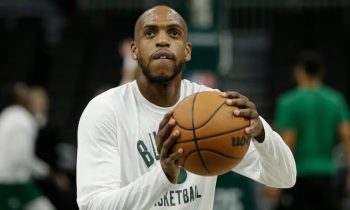NBA
The Education of Gerald Green

There are a lot of things Gerald Green would have done differently throughout his NBA career. How he started it is not one of them.
Green entered the NBA Draft in 2005 from Gulf Shores Academy in Houston, Texas, prior to the league eliminating the possibility of making the jump straight from high school. He was a teenager at the time who thought he was ready to tackle the pros. College was of little interest to him.
The high-flying dunker was quickly grounded, though, as he bounced around to four teams in as many seasons. He was out of the NBA by 2009. If Green were to start his career all over again, he wouldn’t change its beginning.
“I had an opportunity to fulfill my dream, so I did it,” Green said. “If I had to make that decision again, I’d do the same thing over again. Absolutely, without a question. I’d go right out of high school. I don’t do college.”
Green’s mother wanted her son to receive a college education. He joked that since he put his sister through school, he has already paid his tuition. He also said he would not deter another teenager from pursuing the college route.
By going straight to the pros, Green got a different kind of training — a crash course to life in the NBA. But unlike a semester-long course, it took a few years for the lessons to resonate.
Green was, well, green when the Celtics selected him with the 18th pick. Former head coach Doc Rivers held his team to high standards, and the disconnect between the former player and rookie was often apparent on the court.
“I just think you have to have a different mindset playing for Doc,” Green reflected. “If you have a ‘work hard every day, take this as a business, be serious’ type of attitude with Doc, I think you’ll be successful. I was just too young. I was too young.”
The Celtics traded Green to the Minnesota Timberwolves in 2007 as part of the Kevin Garnett deal. He then landed on the Houston Rockets and Dallas Mavericks before going overseas to play two seasons in Russia.
All those things he had learned early in his career — the ones that hadn’t clicked — began to sink in. Green was ready. He wanted to get back in the NBA.
The doors weren’t as open this time, though. The one that was led him to the D-League. He joined the Los Angeles D-Fenders in late 2011. For all the criticism he had received, for all the long bus rides through Russia, for all the times he was humbled, Green had not hit his rock bottom. Until then.
“Going to the D-League (was my rock bottom),” Green said. “I went from making first round draft pick money to D-League money. Players don’t understand, when you get drafted and go to the D-League, that’s nothing. You’re just going down to play. When you actually can’t make a team and you have to go to a D-League, that’s different. Especially when you’ve already been in the league. That’s what was tough for me.”
In the winter of 2012 Green added a new award to his NBA slam dunk contest trophy by winning the D-League All-Star Game MVP honors. The Brooklyn Nets signed him for the remainder of the season.
Green inked a contract with the Indiana Pacers that summer and was traded to the Phoenix Suns in 2013. Head coach Jeff Hornacek told Green there would be minutes for him if he earned them. He has been flourishing since then.
Green, now 28, has taken on a veteran role. He wanted to set an example for his younger teammates by running the floor, knocking down shots and playing with energy on both ends of the court. This season he is averaging 13.9 points and 2.8 rebounds in 20.8 minutes off the bench.
“He’s kind of our instant-offense guy,” said Hornacek. “When we put him in there, we run stuff for him and try to see if we can get him going because when he gets going, it’s lights-out sometimes.”
Nine years after leaving high school for the NBA, Green has established the career he always imagined he could have. For every step he takes forward, he is reminded of his past. The successes he achieves at this stage are paired with references to how far he has come, how close he was to losing his dream of the NBA.
“I feel like I’ve been through a lot,” Green said. “A lot of players don’t really understand what it means to hit rock bottom. I do. I try to tell a lot of players that ‘Hey man, once you hit rock bottom sometimes you’re too banged up to even come back up to the top.'”
That’s a lesson he had to teach himself.













